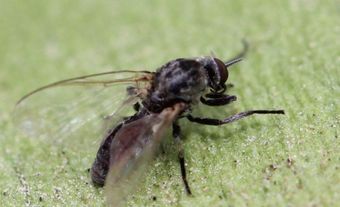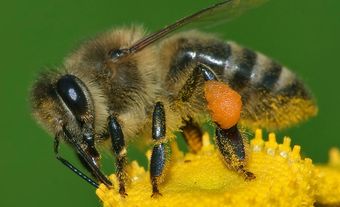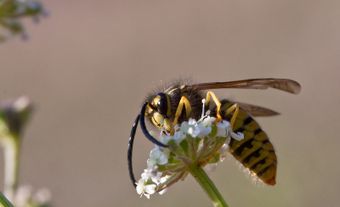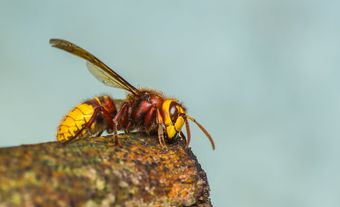Hoverflies, also known as flower flies, are members of the family Syrphidae within the insect order Diptera (true flies). There are over 6,600 known species of hoverfly, including 539 recorded species in Canada. Hoverflies are found in every Canadian province and territory, including as far north as Ellesmere Island. Adults feed on nectar and pollen, making them important pollinators in a variety of habitats. Many hoverfly species are threatened by habitat destruction and the introduction of non-native species.

Description and Mimicry
Hoverflies vary in terms of shape and colour depending on the species, and range from between 4 mm and 25 mm in length. Most adult hoverflies are mimics of wasps and bees, meaning that, like wasps and bees, adult hoverflies often have yellow and black stripes, pointed abdomens and, occasionally, elongated antenna. Known as deceptive or Batesian mimicry, the flies, which cannot bite or sting, look and behave like stinging insects for protection from predators. Some hoverflies closely mimic a specific species, such as honeybees, yellowjackets or bumblebees, while others resemble bees and wasps in general.
Identification
The best way to determine whether an insect is a fly versus a wasp or a bee is to examine the wings: flies only have two wings, while most insects (including wasps and bees) have four. Flies have replaced their hindwings with a pair of halteres, which resemble tiny clubs and are believed to help with flight orientation and stabilisation.
Additionally, hoverflies tend to have proportionally larger heads and smaller antennae than wasps and bees. They also don’t have any biting mouthparts or stingers.
Distinguishing hoverflies from other flies is more difficult, as there are many types of flies that mimic wasps and bees. One method of determining that a fly is a hoverfly (i.e., a member of the family Syrphidae) is to look at the pattern of wing veins. The vast majority of hoverflies have what is known as a “spurious vein,” which does not connect to any of the other wing veins. This is a trait that other flies do not have.

Distribution and Habitat
Hoverflies live all over the world, in nearly all types of habitats. They can be found in every Canadian province and territory, including on Ellesmere Island, the northernmost part of Canada. Hoverfly habitats include tundra, woodland, alpine and grassland areas.
Within these habitats, adult flies can often be found in sunny patches with flowers, at sap runs on trees, at sources of honeydew secretion, and near fresh water.
In Canada and other temperate regions, different species of hoverfly survive the winter in different ways. Depending on the species, they do so as pupa, larvae or adults. Common overwintering strategies include hibernating in leaf litter, underground, under tree bark, underwater or by migrating south.
Reproduction and Development
Like all flies, hoverflies are holometabolous, meaning they go through complete metamorphosis from larva to pupa to adult insect. In the species whose reproduction have been studied, female hoverflies can lay from 120 to 4,500 eggs in their lifetime. The eggs are laid near (or even on) food sources for the larvae once they hatch. Larva will shed their exoskeleton three times before transforming into a pupa.
Larval Diet
The diets of hoverfly larvae are extremely varied. Many known hoverfly species spend their larval stage as predators of aphids and other pest insects. Other species are important decomposers, eating decaying organic matter, which helps to move nutrients through the ecosystem. Still others eat plants, fungi, or aquation plankton, to name a few.
Adult Diet and Pollination
Nearly all species of adult hoverflies are known to visit flowers; the energy from the nectar is essential to power their flight, and the protein from the pollen is important for egg production in females. These frequent visits make hoverflies important pollinators in many ecosystems. In Arctic and mountain communities, a lower diversity of bees makes flies the primary pollinators. For example, in the Arctic and subarctic, hoverflies are known to be important pollinators of cloudberries and wild rhubarb.
Hoverflies are also important pollinators in early spring. This is essential for crops with early spring flowers, such as lowbush blueberry, cranberry and apples.
In addition to nectar from flowers, many hoverflies also feed on tree sap and aphid honeydew, which are high in sugars.
Predators
Predators of hoverflies include birds, against which their mimicry is hypothesized to offer some protection. Other vertebrate predators may be significant as well, but few have been studied as predators of hoverflies.
Hoverflies are also prey to various types of invertebrates, including spiders, wasps and predatory flies. Additionally, hoverfly larvae are hosts to a variety of parasitoid wasp species.

Status and Threats
As with many insects, hoverflies face several conservation threats. The primary threats to hoverflies are habitat loss, habitat fragmentation, loss of native biodiversity and the introduction of non-native species. In Canada, hoverfly species native to prairies and savannah are particularly at risk, where much of this habitat has been converted into farmland.
While the majority of hoverfly species have not been evaluated for their conservation status, several species are known to be in decline. For example, the hourglass drone fly (Eristalis brousii), once widespread across North America, is now only found in a small number of locations along the coast of Hudson Bay. Their decline is associated with the introduction of the closely related European drone fly (Eristalis arbustorum), which may have displaced and out-competed the native hourglass drone fly throughout the majority of North America.

 Share on Facebook
Share on Facebook Share on X
Share on X Share by Email
Share by Email Share on Google Classroom
Share on Google Classroom



